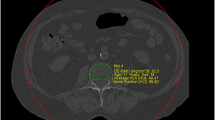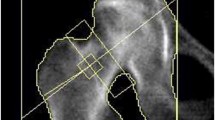Abstract
Dual-energy X-ray absorptiometry (DXA) of the lumbar spine provides an estimation of the bone mineral content (BMC) corrected by the projected area of the spine and expressed in g/cm2. This two-dimensional estimate of the bone mineral density (BMD) is influenced by the skeletal size, assessed by the subject's height. In order to obtain an estimate of the volumetric BMD, we measured BMC with a new DXA device (Sophos L-XRA) equipped with 24 detectors and a rotating arm, thus allowing scanning of the lumbar spine in both an anteroposterior (AP) projection and a lateral (LAT) projection with the patient in a supine position. Comparison between the results obtained on the third (L3) and fourth (L4) lumbar vertebrae with automatic or manual analysis showed that the best precision was obtained with the lateral measurement of L3 alone with an automatic soft tissue baseline determination. Results were expressed in g/cm2 and in g/cm3 (by dividing the g/cm2 value by the width (AP area divided by the height of the vertebra) of L3), and were compared with those obtained by conventional AP scanning of L2–4 (g/cm2). The in vivo precision error evaluated by triplicate measurements on 10 controls was 17 mg/cm2 (1.96%) and 5.2 mg/cm3 (2.31%) for LAT L3 as compared with 13 mg/cm2 (1.15%) for AP L2–4. Volumetric BMD (g/cm3) measurement, assessed in vitro on a calibrated hydroxyapatite phantom, and the absolute values obtained in normal women were similar to those obtained by quantitative computed tomography (QCT). In 39 healthy adults (27±4 years) BMD expressed in g/cm2 was correlated with height (r=0.36 for AP L2–4 andr=0.39 for LAT L3;p<0.05 for both) but not with LAT L3 BMD expressed in g/cm3 (r=0.02; NS). The age-related bone loss between 30 and 80 years of age, derived from the normal values for 101 healthy women (age range 19–73 years) was 36% for AP L2–4, 52% for LAT L3 (g/cm2) and 60% for LAT L3 (g/cm3). In a group of 22 women with untreated postmenopausal vertebral osteoporosis (one or more non-traumatic vertebral crush fractures) the mean decrease in BMD, expressed as a percentage of the age-adjusted normal value, was more pronounced (p<0.001) for LAT L3 BMD (−21% in g/cm2,Z-score −1.08; −22% in g/cm3,Z-score −0.94) than for AP L2–4 BMD (−9%,Z-score −0.66). We conclude that: 1) BMD measurement restricted to the vertebral body of L3 can be achieved with a low precision error with this new DXA device; 2) it allows an estimate of the volumetric density (g/cm3) which does not seem to be influenced by skeletal size; 3) lateral BMD appears to be more sensitive than conventional AP scanning for assessing age-related bone loss and should be useful in the investigation of trabecular osteoporosis.
Similar content being viewed by others
References
Johnston CC, Slemenda CW, Melton LJ III. Clinical use of bone densitometry. N Engl J Med 1991;324:105–9.
Genant HK, Steiger P, Faulkner KG, Majumdar S, Lang P, Glüer CC. Non-invasive bone mineral analysis: recent advances and future directions. Osteoporosis. Third International Symposium on Osteoporosis, Copenhagen, Denmark, 1990:435–41.
Johnson JB, Dawson Hughes B. Precision and stability of dual energy X-ray absorptiometry measurements. Calcif Tissue Int 1991;49:174–8.
Ott SM. Methods of determining bone mass. J Bone Miner Res 1991;6 Suppl 2:S71–6.
Eastell L, Mosekilde L, Hodgson SF, Riggs BL. Proportion of human vertebral body bone that is cancellous. J Bone Miner Res 1990;5:1237–41.
Parfitt AM. Bone remodeling: relationships to the amount and structure of bone and the pathogenesis and prevention of fractures. In: Riggs BL, Melton LJ III, editors. Osteoporosis: etiology, diagnosis and management. New York: Raven Press, 1988;45–94.
Rockoff SD, Sweet E, Bleustein J. The relative contribution of trabecular and cortical bone to the strength of human lumbar vertebrae. Calcif Tissue Res 1969;3:163–75.
Duboeuf F, Braillon P, Chapuy MC, Hardouin C, Meary MF, Delmas PD, Meunier PJ. Hip bone mineral measurement with dual-energy X-ray absorptiometry in normal elderly women and in patients with hip fracture. Osteoporosis Int 1991;1:242–8.
Carter DR, Bouxsein ML, Marcus R. New approaches for interpreting projected bone densitometry data. J Bone Miner Res 1992;7;137–45.
Pacifici R, Rupich R, Griffin M, Chines A, Susman N, Avioli LV. Dual energy radiography (DER) versus quantitative computed tomography (QCT) for the diagnosis of osteoporosis. J Clin Endocrinol Metab 1990;70:705–10.
Uebelhart D, Duboeuf F, Meunier PJ, Delmas PD. Lateral dual photon absorptiometry: a new technique to measure the bone mineral density at the lumbar spine. J Bone Miner Res 1990;5:525–31.
Uebelhart D, Duboeuf F, Meunier PJ, Delmas PD. Vertebral bone mineral density (BMD) measurement assessed by lateral dual-photon absorptiometry. Calcif Tissue Int 1989; Suppl 44: abstr J33.
Rupich RC, Pacifici R, Griffin M, Vered I, Susman N, Avioli LV. Lateral dual energy radiography: a new method for measuring vertebral bone density. A preliminary study. J Clin Endocrinol Metab 1990;70:1768–70.
Slosman DO, Rizzoli R, Donath A, Bonjour JP. Vertebral bone mineral density measured laterally by dual-energy X-ray absorptiometry. Osteoporosis Int 1990;1:23–9.
Rupich RC, Griffin MG, Pacifici RP, Avioli LV, Susman N. Lateral dual energy radiography: artifact error from rib and pelvic bone. J Bone Miner Res 1992;7:97–101.
Schmitz S. Steiger P, Lang P, Genant HK. Lateral dual X-ray absorptiometry of the spine: the impact of the region of interest on diagnostic sensitivity. In: Proceedings of the third international symposium on osteoporosis, Copenhagen, Denmark, October 1990.
Braillon P, Bochu M, Meunier PJ. Precision of dual energy quantitative computer tomography (DE QCT) in bone density measurements measured on two phantoms. In: Proceeding of the eighth international workshop on bone densitometry, Bad Reichenhall, Germany, 1991.
Karantanas, Kalef JA, Glaros DC. Quantitative computed tomography for bone mineral measurement: technical aspects, dosimetry, normal data and clinical application. Br J Radiol 1991;64:298–304.
Cann CE, Genant HK, Ettinger E, Kolb F. Quantitative computed tomography for prediction of vertebral fracture risk. Bone 1985;6:1–7.
Braillon P. MD thesis, Claude Bernard University, Lyon, 1987: no. 391.
Souza ACA, Nakamura T, Shiraki M, Stergiopoulos K, Ouchi Y, Orimo H. Measurement of vertebral body using dual energy X-ray absorptiometry in lateral projection. In: Christiansen C, Overgaard K, editors. Osteoporosis. Third international symposium on Osteoporosis, Copenhagen, Denmark, 1990: 640–2.
Devogelaer JP, Baudoux C, Nagant de Deuchaines. Reproducibility of BMD measurements on the QDR-2000 Hologic, Inc. [Abstract from the ninth international bone densitometry workshop, Traverse City, Michigan.] Calcif Tissue Int 1993;52:153–80.
Mazess RB, Gifford CA, Bisek JP, Barden HS, Hanson JA. DEXA measurement of spine density in the lateral projection: methodology. Calcif Tissue Int 1991;49:235–9.
Pouilles JM, Tremollieres F, Todorovsky N, Ribot C. Precision and sensitivity of dual energy X-ray absorptiometry in spinal osteoporosis. J Bone Miner Res 1991;6:997–1002.
Mautalen C, Vega E, Ghiringhelli G, Fromm G. Bone diminution of osteoporotic females at different skeletal sites. Calcif Tissue Int 1990;46:217–21.
Economou G, Rushton S, Adams JE, Whitehouse RW. Precision of lateral DXA and correlation with QCT. [Abstract from the ninth international bone densitometry workshop, Traverse City, Michigan.] Calcif Tissue Int 1993;52:153–80.
Peel NFA, Eastell R. Estimated volumetric bone mineral density of the vertebral body by DEXA: comparison with planar measurements in osteoporosis. [Abstract from the ninth international bone densitometry workshop, Traverse City, Michigan.] Calcif Tissue Int 1993;52:153–80.
Mazess RB, Barden H, Mautalen C, Vega E. Sensitivity of DEXA for spine fracture. [Abstract from the ninth international bone densitometry workshop, Traverse City, Michigan.] Calcif Tissue Int 1993;52:153–80.
Sabin MA, MacLaughlin SM, Blake GM, Fogelman I. A study of the accuracy of lateral and volumetric spinal bone density measurements with the Hologic QDR 2000. [Abstract from the ninth international bone densitometry workshop, Traverse City, Michigan.] Calcif Tissue Int 1993;52:153–80.
Glastre C, Braillon P, David L, Cochat P, Meunier PJ, Delmas PD. Measurement of the bone mineral content of the lumbar spine by dual energy X-ray absorptiometry in normal children: correlactions with growth parameters. J Clin Endocrinol Metab 1990;70:1330–3.
Reid IR, Evans MC, Stapleton J. Lateral spine densitometry is a more sensitive indicator of glucocorticoid-induced bone loss. J Bone Miner Res 1992;7:1221–5.
Author information
Authors and Affiliations
Rights and permissions
About this article
Cite this article
Duboeuf, F., Pommet, R., Meunier, P.J. et al. Dual-energy X-ray absorptiometry of the spine in anteroposterior and lateral projections. Osteoporosis Int 4, 110–116 (1994). https://doi.org/10.1007/BF01623234
Received:
Accepted:
Issue Date:
DOI: https://doi.org/10.1007/BF01623234




